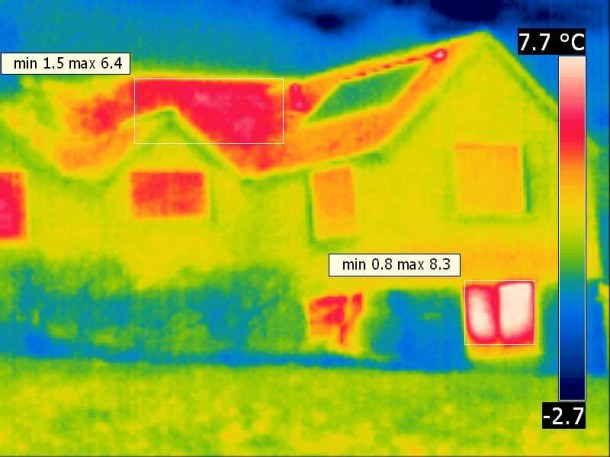AT HOME – ABC TARGETING HEAT LOSS
A hot roof means heat is being lost which costs you money – whether it’s at home or at work!
Getting this right means connecting behaviour, technology and the way you run your buildings.
This picture shows high surface temperatures on this roof – a hot spot to target. Our associate, Alun Ottley, and I discovered this and other opportunities when we recently surveyed a building with a thermal image camera.
Targeting heat loss is as easy as ABC – discover how you can make savings:
A: Adjust your behaviour – Try turning down your thermostat by 1°C for a few days in areas you use often – if you find you can quite happily live with this, you’ll save 8 to 10% of your heat costs over a year! Look at other areas that you don’t use often, and consider turning the heating right down. Reviewing temperatures and comfort levels needs to be the first step.
B: Boot up the thermal camera – When it’s cold outside and your heating system has settled down (i.e. it’s been on for at least a few hours) you can start the survey. You need to look at the outside surfaces of the house (outside looking in) and the inside surfaces (inside looking out) both from a distance, to look for patterns of heat loss, and close in, to look for local cold bridges and air leaks.
Some examples:
- A hot roof (shown in red) – hot air is bypassing the loft insulation layer and entering the loft space from the sides.
- A cold bridge (shown in blue) – in the corner of the room; there may be an opportunity to add insulation in the cavity and/or on the outside wall of the house.
- A hot door (shown in red) – a door running hotter than the other windows and doors; this is the place to start an upgrade when
the opportunity arises.
C: Cut your costs – Plugging leaks may be as simple and low cost as using decorator filler on small cracks (which leak air) and stripping for the larger holes and gaps (which cause draughts) or repositioning the insulation where the continuous insulation layer has been broken.
It may be well worth the investment of increasing insulation levels – with energy costs generally rising, the basic rule of thumb is to add as much insulation as you can afford and that’s easy to fix, while making sure you avoid any condensation issues (on the colder side of the insulation layer).
Targeting heat loss is a great way to improve comfort, reduce carbon emissions and cut heating costs. Using a thermal camera allows you to pin point the best opportunities; these days most cameras come with software that automatically generates a heat loss report for you.
TO DISCOVER FOR YOURSELF
1. Interested in discussing what we can do for you – get in touch.
2. For more ideas, join our mailing list and/or subscribe to our RSS feed.



Comments